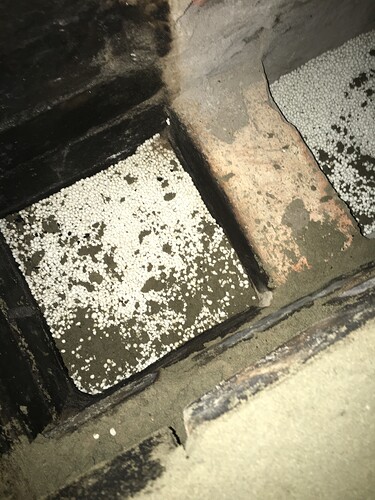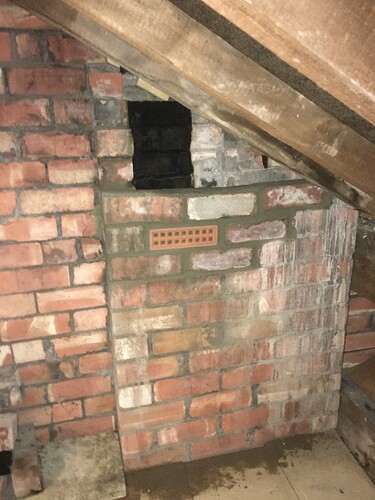Hello again. When people talk of filling chimneys with LECA lightweight expanded clay aggregate or similar, I always assumed that the flue was removed first and the entire space was filled. Am I right? or do you have to keep the flue - maybe block it at the bottom with something breathable?
I have read this very helpful comment Chimney stack removal - #8 by don_helen from @don_helen - but it wasn’t 100% clear to me.
1 Like
If filling a chimney, no voids should be left. This means that any flue liners have to be removed. If, on the other hand, the chimney is brought below the loft line, so that the remaining structure is within the thermal envelope, no filling is required and the space can be utilised for ducts, plumbing or wiring. You could even fit a dumb waiter if you wanted.
2 Likes
Hi Jonathan, to clarify our chimney wasn’t lined with a flue, just brickwork approx. 9” square.
The stack was removed and brickwork brought down into loft but above loft insulation depth.
We chose the foam glass bubbles (Geocell) over other mineral materials because of their inert, non wicking, low density, structural integrity & non clumping properties.
We didn’t airtight seal at fireplace end to allow some breathability.
I have noticed the original post needs editing it has the wrong size, we used the 4-8mm bubbles (not 2-4).
Thanks both. I think I have been under a misconception. Our chimney breast is 1.5 m wide at the ground floor. I always assumed it was a hollow space with a flue somehow supported up the centre. Now I’m thinking it’s 1.5 m of solid masonry with a narrow airway in the middle called the flue.
1920s brick terrace for what it’s worth
I can’t comment on your construction but can tell you about mine, 1936.
The chimney is as wide as yours and the void behind the fireplace is at least a metre wide. I discovered that when I bought a chimney sheep some years ago and it had nothing to hold it in place. As far as I can tell that void is at least as tall as me (180cm). I imagine that when the fire was lit the whole chimney breast worked as a radiator, and to some extent a storage heater. I dare say that at the time it was cutting edge technology.
That’s small compared with my childhood home, with a 3 metre wide inglenook with a concealed priests’ hole. I expect that any hidden priest would have got very hot but searching troops were unlikely to look too carefully behind the flames.
Our house is a 1910 semi. In rooms the chimney breast is a similar width to yours and runs from ground floor up through bedroom ceiling. It’s brick construction and accommodates two 9” holes/flues side by side one from ground floor & one from bedroom. Bedroom fireplace had long since been blocked off before we moved in.
We filled both from the loft as described previously.
Viewed from above in loft see two holes filled with geocell bubbles. Left was from the recently active fire place hence soot.
View from side see width of chimney breast brickwork which used to rise through roof. Picture taken before insulation
We swept the chimney from bottom to top & top to bottom before filling, pleased to say we didn’t find any priests or Victorian children.
Hope this helps. Don
Tried to include photos not sure if it’s worked
2 Likes
Very interesting. I am also currently getting quotes for removing my chimney breast in my 1945 semi.
I suspect behind the plaster is something similar you describe, but not yet sure how much should be taken and how to seal it off. I just want the extra space in the living room and close the massive air gap.
Thanks for sharing!
Yes my original post was quite naive in that I didn’t understand the anatomy of a chimney stack. I had a notion they were hollow but ours are in fact constructed of solid masonry blocks but with circles cut out to form the flues. We just finished getting ours filled with leca. Next phase is to address some of our Airtightness issues under our kitchen cupboards at the floor/wall junction
1 Like
When we moved into our house we found that the previous owner had removed the dining room chimney breast but not supported the remaining chimney above. Our builder told us that opening up the ceiling. Putting in proper supports and making good would cost about the same as removing the rest of the chimney. Naturally we went for full removal with the bonus of increased space in the room above. The first floor chimney was more brick than air, containing an old fireplace and two flues. Not having lived in the house both before and after I cannot comment on the benefit energy wise. We are however planning to remove the remaining chimney.
As an added advantage, removing chimneys reduces shading for solar panels and removes bird roosts, indirectly reducing firtile deposits on panels which may then get moss growth.
1 Like
Thanks. How long did it take the builder to remove the chimney? Did you remove it also in the loft through the roof?
The builder I had around recently also said it would be better to remove also the stack in the first floor and put some structural support in the loft space to keep the chimney up without having to redo the roof. I haven’t had a quote yet, so not sure if I can afford it.
However, as it is a semi-detached house, I am unsure how connected the chimney to the neighbours and I will need a party wall agreement first anyway. So just now looking into how to deal with it.
So any advice is much appreciated.
I’m afraid I don’t remember how long the removal took. Not long. The making good afterwards took longer. That was in 1984 and I was at work during the day, so all in no data.
Unfortunately the chimney is shared with our semi detached neighbours and to this day they still use their half, so we couldn’t take out the whole chimney. Enough had to be left in the loft, with gallows irons, to support the chimney above. The amount to leave has since become more stringent, so instead of chest high as we have you might end up with knee high. If possible remove the whole thing.
I have let my neighbours know that if ever they stop using the chimney I am in favour of removal.
1 Like
A scant day each to remove 2 chimneys to below the roofline. They took the chimney down just a few inches clear of the roof. Poured in the insulation and capped the chimneys with a vent, all from above the roof. Then slated over the gap in the roof.
Rain had leaked in around the chimney over the years, and the nearby timbers were not in a good state. The builder replaced the first wooden support from the ridge to the gutter before slating over.
A milestone reached. Congratulations.
Given that the chimney was only reduced to just below roof height it isn’t surprising that not much time was needed. I imagined it going down to ceiling height.
Do you intend to remove the chimney from each room as you do other work or is the current state a permanent one?
This is a permanent state of affairs, carried out in accordance with the PPR chimney cap/fill spec. The chimney remove option in that spec says remove the chimney to the loft area. we don’t expect to be touching the chimneys again. It’s rather final filling the flues with tiny beads, I can imagine a future occupant inadvertently turning a room into a ball pool if they mess around with the fireplace fender too much!
Anecdotally the air in the house seems stuffier than before, which is a sign that the work has improved airtightness or decreased the rate of airflow through the envelope. No noticeable improvement in the size of the gas bill compared with last year though. Insufficient data really, and no record of outdoor temperatures to compare.
Yes, if no adhesive was used with the beads then future owners may well be in for a shock when they decide to get rid of the chimney breast.
I would use gallows brakets in the attic to support the upper part of the chimney. Then remove everything below to make more space.
An engineer will have to specify bracket size to be safe. But you could do the bracket and the deconstruction of the chimney yourself if you feel confident and dont mind getting your hands dirty.
If leaving the chimney in and filling using LECA try to ensure they are dry. Often they are kept outdoors at builders yards and garden centers and can be wet. You do not want that going into your house.
1 Like
“No noticeable improvement in the size of the gas bill compared with last year though. Insufficient data really, and no record of outdoor temperatures to compare.”
@Jonathan_Whitehead have you come across degreedays.net?
Heating & Cooling Degree Days – Free Worldwide Data Calculation
If you choose a suitable baseline temperature for when you require heating, you can download hours of heating required by day/week/month for the last 3 years and compare heating energy use accordingly. I also use Weather History & Data Archive | Weather Underground to log average daily temperatures (min and max, and data over different periods also available).
3 Likes
Thanks Sian that’s better. February gas bill was same as Feb 2024, but this year had 50 more degree days, representing a 15-25% efficiency improvement after filling the chimneys, depending on what my base temperature should be. Based on one month’s data!
3 Likes
Thats very useful. Thanks
That’s impressive! One of my unused chimneys is bricked up, and the other blocked off but not capped or filled or properly ventilated. Might have to add to the to-do list, if it’s made that much difference!

